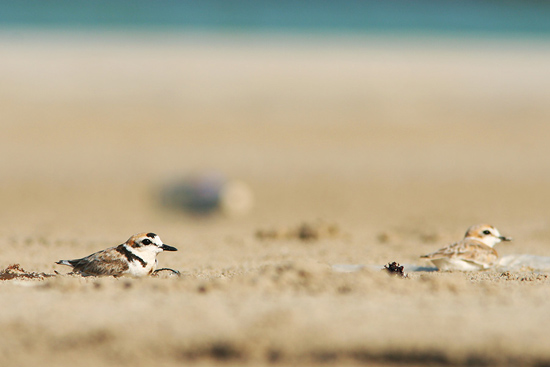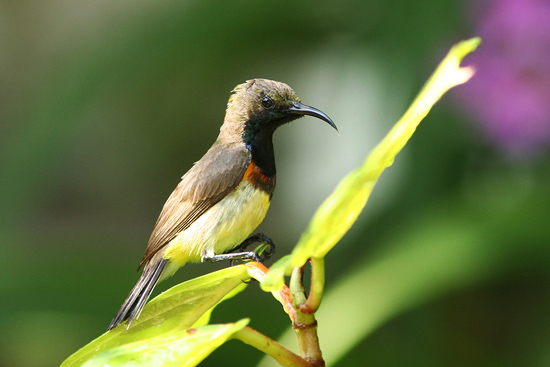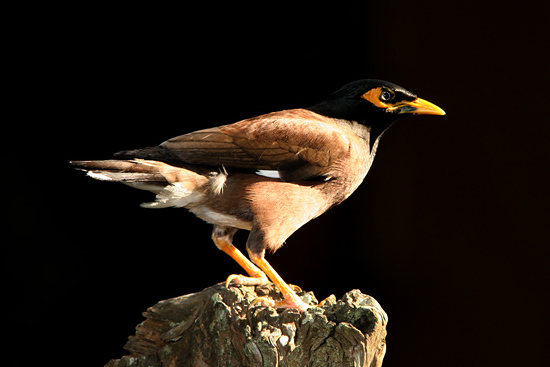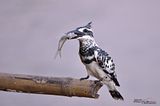We stayed the night in a small A-Frame house in Ang Kang health station's area. The next morning we found a flock of about 6 Striated Swallows (Hirundo striolata) perching on electrical wires in front of the station. We later found many these throughout the trip. Other birds that were seen around the station include Red-whiskered Bulbuls, Sooty-headed Bulbuls, Oriental Magpie-Robins and Spotted Doves.
We then moved to Ban Luang area for birding and luckily came across this young Peregrine Falcon (Falco peregrinus) perching on the roadside. The bird has reddish underparts with black cheeks indicating that it's a subspecies F.p.peregrinator. The bird later flew out and caught a couple of high flying butterflies, presumably Birdwing species (Troides spp.), but constantly dropped them off while eating in midair.
On the roadside near Ban Luang village, there was a fruiting tree which attracted many different species of birds, mainly bulbuls and this Dark-backed Sibia (Heterophasia melanoleuca). The bird has a remarkable thrilling call which can be heard easily throughout Doi Angkang. Other birds that came to feed were Crested Finchbill, Flavescent Bulbul, Sooty-headed Bulbul and Silver-eared(Chestnut-crowned) Laughingthrush.
We went for lunch at a small restaurant in Nor Lae village, which is pretty well known among birders in Chiang Mai. The restaurant's called Tama-Taté. After lunch, we did a small walk around an orchard inside the military camp nearby and found many small birds including the above 2 species of sunbirds. The bird in the big picture is an eclipse male Olive-backed Sunbird (Cinnyris jugularis), while the other in the two smaller pics below is an eclipse male Purple Sunbird (Cinnyris asiaticus). Though looking almost identical in eclipse plumage, you can see that the Olive-backed Sunbird has much yellower underparts, while the Purple's is dull greyish. The second pic of the bird also shows purplish-blue glossy feathers on its rump and tail indicating that it's a Purple not Olive-backed Sunbird.
 Later we were chased by the rain and finally ended up chilling at the luxurious Royal Project's restaurant. From the restaurant, we saw many Red-whiskered Bulbuls which were posted earlier in this entry. Not only there were bulbuls, this beautiful male Black-throated Sunbird (Aethopyga saturata) was also flicking around as well. Unfortunately, due to very low light thus low speed shutter and the rapid movement of the bird, the above shot was the only shot that is acceptable.
Later we were chased by the rain and finally ended up chilling at the luxurious Royal Project's restaurant. From the restaurant, we saw many Red-whiskered Bulbuls which were posted earlier in this entry. Not only there were bulbuls, this beautiful male Black-throated Sunbird (Aethopyga saturata) was also flicking around as well. Unfortunately, due to very low light thus low speed shutter and the rapid movement of the bird, the above shot was the only shot that is acceptable.




































 This was from March 2008, before I came to Japan. Me and my family, we went on a trip before I said goodbye to my motherland. Chumphon is a province located on the east side of Thai peninsula. It is famous for its beautiful beaches and islands, and is also one of the best places to watch migrating raptors! We stayed at our favorite resort, the 'Chumphon Cabana', which located in the area of Thung Wua Lan beach, one of the most famous beaches in Chumphon. Though this doesn't sound like there's gonna be any good birds, but actually it does. I have seen Malaysian Plover (Charadrius peronii), an uncommon resident plover of southern Thailand, almost everytime I come here. And of course, this time with the DSLR, I could finally get some nice shots of them! :))
This was from March 2008, before I came to Japan. Me and my family, we went on a trip before I said goodbye to my motherland. Chumphon is a province located on the east side of Thai peninsula. It is famous for its beautiful beaches and islands, and is also one of the best places to watch migrating raptors! We stayed at our favorite resort, the 'Chumphon Cabana', which located in the area of Thung Wua Lan beach, one of the most famous beaches in Chumphon. Though this doesn't sound like there's gonna be any good birds, but actually it does. I have seen Malaysian Plover (Charadrius peronii), an uncommon resident plover of southern Thailand, almost everytime I come here. And of course, this time with the DSLR, I could finally get some nice shots of them! :))


 A male Olive-backed Sunbird taking bath on waterdrops left on the leaves
A male Olive-backed Sunbird taking bath on waterdrops left on the leaves

 A juvenile male Oriental Magpie-Robin
A juvenile male Oriental Magpie-Robin












.jpg)
